Related Research Articles

Charles Henry Holden was an English architect best known for designing many London Underground stations during the 1920s and 1930s, the Underground Electric Railways Company of London's headquarters at 55 Broadway, for the University of London's Senate House and for Bristol Central Library. He created many war cemeteries in Belgium and northern France for the Imperial War Graves Commission.

Haddenham is a village and civil parish in west Buckinghamshire, England. It is about 5 miles (8 km) south-west of Aylesbury and 4 miles (6 km) north-east of Thame in neighbouring Oxfordshire. At the 2011 Census, the population of the civil parish was 4,502.
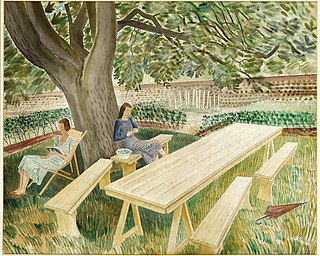
Eric William Ravilious was a British painter, designer, book illustrator and wood-engraver. He grew up in Sussex, and is particularly known for his watercolours of the South Downs, Castle Hedingham and other English landscapes, which examine English landscape and vernacular art with an off-kilter, modernist sensibility and clarity. He served as a war artist, and was the first British war artist to die on active service in World War II when the aircraft he was in was lost off Iceland.

Erich Mendelsohn ; 21 March 1887 – 15 September 1953) was a German-British architect, known for his expressionist architecture in the 1920s, as well as for developing a dynamic functionalism in his projects for department stores and cinemas. Mendelsohn was a pioneer of the Art Deco and Streamline Moderne architecture, notably with his 1921 Mossehaus design.

The De La Warr Pavilion is a grade I listed building, located on the seafront at Bexhill-on-Sea, East Sussex, on the south coast of England.
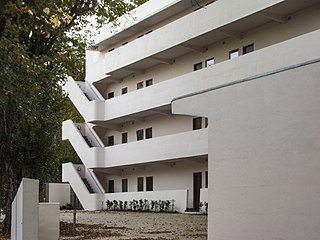
The London-based Isokon firm was founded in 1929 by the English entrepreneur Jack Pritchard and the Canadian architect Wells Coates to design and construct modernist houses and flats, and furniture and fittings for them. Originally called Wells Coates and Partners, the name was changed in 1931 to Isokon, a name derived from Isometric Unit Construction, bearing an allusion to Russian Constructivism.
Raymond McGrath was an Australian-born architect, illustrator, printmaker and interior designer who for the greater part of his career was Principal Architect for the Office of Public Works in Ireland.
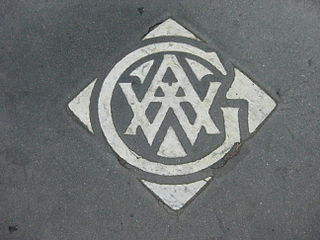
The Art Workers' Guild is an organisation established in 1884 by a group of British painters, sculptors, architects, and designers associated with the ideas of William Morris and the Arts and Crafts movement. The guild promoted the 'unity of all the arts', denying the distinction between fine and applied art. It opposed the professionalisation of architecture – which was promoted by the Royal Institute of British Architects at this time – in the belief that this would inhibit design. In his 1998 book, Introduction to Victorian Style, University of Brighton's David Crowley stated the guild was "the conscientious core of the Arts and Crafts Movement".

Serge Ivan Chermayeff was a Russian-born British architect, industrial designer, writer, and co-founder of several architectural societies, including the American Society of Planners and Architects.
Roderick Gradidge AA Dipl. ARIBA was a British architect and writer on architecture, former Master of the Art Workers Guild and campaigner for a traditional architecture.

Dennis Sharp was a British architect, professor, curator, historian, author and editor. His obituary in The Guardian stated that he 'was well-known as an architectural historian, teacher and active defender of the environment. However, his reputation in those fields rather overshadowed his considerable success as a working architect and his long-term commitment to environmentally friendly building'.
Margaret MacGregor Angus was a British painter, designer and teacher. Born in Chile, she spent her career in Britain.

Enid Crystal Dorothy Marx, RDI, was an English painter and designer, best known for her industrial textile designs for the London Transport Board and the Utility furniture Scheme. Marx was the first female engraver to be designated as a Royal Designer for Industry.
Geoffrey Bazeley (1906–1989) was a British Modernist architect, born in Penzance, Cornwall into a family of shipowners and traders. In 1935 he was commissioned to build Tregannick House in Cornwall and set up his own practice there. Tregannick has been described as "one of the best Modern Movement houses in the west of England."
Neave Brown was an American-born British architect and artist. He specialized in modernist housing. Brown is the only architect to have had all his UK work listed: A row of houses in Winscombe Street, the Dunboyne Road Estate and Alexandra Road Estate, all located in Camden.
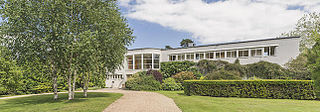
Shrubs Wood is a privately owned, Grade II* listed, Art Deco country house in Chalfont St Peter, Buckinghamshire, England. Built between 1933 and 1934, Shrubs Wood was designed by Erich Mendelsohn and Serge Chermayeff. It is one of only two residential properties designed during their short partnership.
Eugene (Evžen) Rosenberg was a Slovak modernist architect.
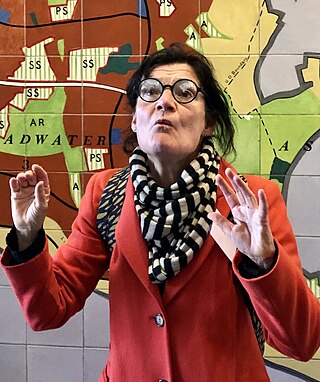
Elain Harwood Hon.FRIBA was a British architectural historian with Historic England and a specialist in post–Second World War English architecture.
Bentley Wood, also known as the House at Halland, is a Modernist house designed by the Russian émigré architect Serge Chermayeff and built in a rural location in the Low Weald in Sussex with views to the South Downs. In the Architects' Journal, Charles Herbert Reilly described it on completion in 1938 as "a regular Rolls-Royce of a house". It is considered to be one of the most influential modern houses of the period. It become a Grade II listed building in March 2020.
Landfall is a house in Poole, Dorset, England, that was built between 1936 and 1938 by the architect Oliver Hill in the modernist style. It has been designated as a Grade II* listed building by Historic England.
References
- ↑ Archived link, University of Greenwich.
- ↑ London School of Architecture
- ↑ "Exhibition - Alan Powers - The Art of an Art Historian". Art Workers' Guild. Retrieved 18 October 2021.
- ↑ "r; teacher; leader for history and theory, London School of Architecture; author, Bauhaus Goes West". Battle of Ideas Festival. Retrieved 21 October 2021.